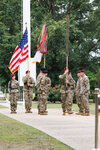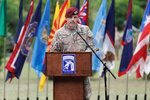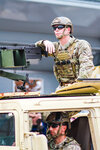



After more than a century of service that saw the installation grow into an integral part of the nation’s defense and its largest installation by population, Fort Bragg has officially been renamed Fort Liberty.
The new name, which took effect June 2, pays tribute to past and future service members by highlighting their roles in global fights for liberty that have seen local troops participate in every major military operation, and many of the most secretive, since the installation was founded in 1918.
Changing to Fort Liberty was part of a Defense Department effort to rename installations, facilities and roads — essentially anything under the purview of the nation’s military — that could be seen as honoring those who voluntarily served in the Confederate Army during the Civil War.
With the new name came new branding, updated street names and a public ceremony marking the change.
It’s not the first time the installation now known as Fort Liberty has had to adapt. From a humble artillery camp to the Home of the Airborne and Special Operations, local soldiers have often changed to keep pace with the nation’s defense requirements.
What has not changed is the installation’s overarching mission to be ready when the nation needs it. Fort Liberty’s unofficial motto has long been, “When the nation calls 911, the phone rings here.” Local troops stand ready to deploy in a matter of hours, and the garrison repeatedly trains throughout the year to get the soldiers supplied and out the door as quickly as possible.
Today’s Fort Liberty is home to more than 51,000 service members and thousands of civilians and government contractors. Key commands include the 18th Airborne Corps, known as the nation’s Contingency Corps, and the 82nd Airborne Division, which provides the majority of the Global Response Force.
Army Special Operations is also headquartered on post, as is the secretive Joint Special Operations Command. And the sprawling installation includes the headquarters of the Army’s largest command, U.S. Army Forces Command, which oversees the bulk of the nation’s warfighters.
Not only a military powerhouse, Fort Liberty is also an economic juggernaut, with a yearly impact of more than $8 billion for the state of North Carolina, with most of that centered on Cumberland and surrounding counties.
Top Commands
• U.S. Army Forces Command: Led by a four-star general, Forces Command is the largest organization in the Army, with oversight over more than 750,000 active and Reserve soldiers.
• 18th Airborne Corps: Known as America’s Contingency Corps, the 18th Airborne trains to deploy on short notice to oversee missions across the world.
• U.S. Army Special Operations Command: The Army’s special operations forces are commanded from Fort Liberty. They include Rangers, Green Berets, elite aviators, and civil affairs and psychological soldiers.
• Joint Special Operations Command: These are the leaders of America’s most elite and secretive units.
• U.S. Army Reserve Command: The headquarters for the Army Reserve is centrally located alongside Forces Command.
• 82nd Airborne Division: The largest single soldier population on Fort Liberty, the 82nd is best known for the Global Response Force and its ability to deploy quickly when needed.
• 1st Special Forces Command: The nation’s irregular warfare experts include its Green Berets.
• U.S. Army John F. Kennedy Special Warfare Center and School: Many of the Army’s most elite forces are trained, tested and vetted at this schoolhouse.
• Security Force Assistance Command: This command oversees the Army’s Security Force Assistance Brigades, which help train and advise partner nations around the world.
• U.S. Army Civil Affairs and Psychological Operations Command: This Army Reserve command has units spread across the nation providing specialized skills that are largely found only in the Reserve component.
Five facts about Fort Liberty
1 Fort What? The name Fort Liberty was chosen after numerous discussions with local stakeholders from the community. Garrison officials said community leaders were having difficulty zeroing in on one name among the installation’s long list of heroes. But they coalesced around the name Liberty at the suggestion of a Gold Star family member, who said her loved one did not die for Bragg but died for liberty.
2 Fort Where? It’s hard to imagine Fayetteville or the North Carolina Sandhills without the looming presence of Fort Liberty. But that was a distinct possibility in the early 1920s, as the Army looked to shutter several training posts that were built during World War I. It was largely the effort of Brig. Gen. Albert Bowley, who commanded Bragg from 1921 until 1928, that saved what was then Camp Bragg and helped lay the foundation for the modern-day post. Bowley would later tell historians his efforts were “politics both Army and civil” that enlisted the aid of local and state leaders to secure the installation’s future.
3 Fort Rare. Fort Liberty is home to several endangered and rare plants and animals. The most notable is the red-cockaded woodpecker, the presence of which threatened the post’s existence in the early 1990s and spurred a conservation effort that has been repeatedly praised for helping protect both military training and the small, palm-sized birds. Other species that call Fort Liberty home include the St. Francis’ Satyr butterfly — the only known population lives on post — and the Venus flytrap, a rare carnivorous plant whose exact locations are a close-kept secret to protect them from poachers.
4 Fort Ball. Then-Fort Bragg made history in the summer of 2018 when Major League Baseball and the Major League Baseball Players Association partnered to host the first regular-season professional sports matchup on an active military base. The Miami Marlins beat the Atlanta Braves 5-2 in the contest, which was broadcast on ESPN. While the grandstands were removed after the game, the field itself is still used by the Fort Liberty community.
5 Fort Food. Fort Liberty is home to nine dining facilities — including a soldier-run food truck launched in 2019 — and numerous other dining options meant to sustain more than 50,000 hungry soldiers each day. The busiest time of the year for Fort Liberty’s food-service professionals is Thanksgiving, when hundreds of soldiers and civilians prepare thousands of pounds of turkey, beef and all the traditional trimmings of the holiday meal.
Visiting Fort Liberty
There are numerous entry points to Fort Liberty, but if you don’t have a military ID, your first stop will be the All American Visitor Control Center.
The center, located where the All American Freeway meets Fort Liberty, is open from 5 a.m. to 9 p.m. daily, including federal holidays. A government-issued ID card, proof of insurance and vehicle registration, as well as a valid reason for entering the installation are required.